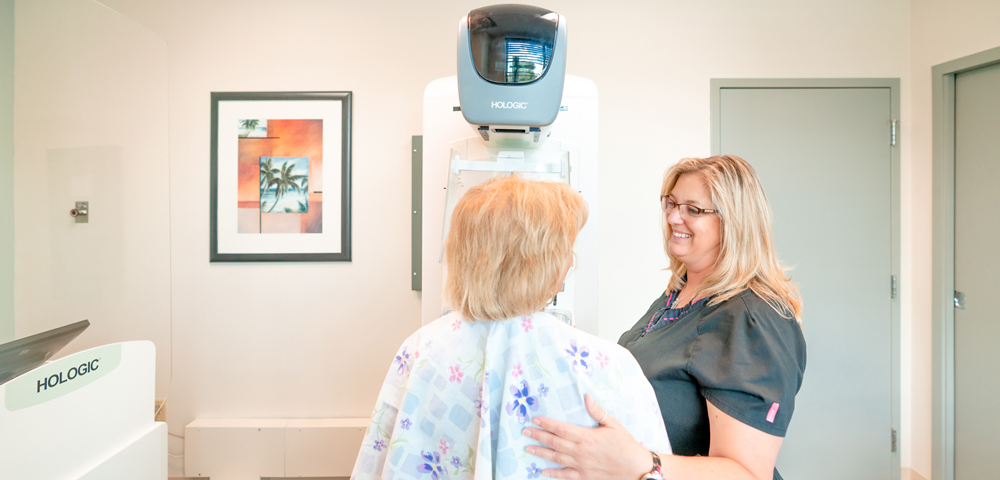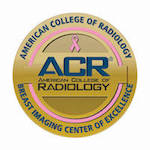Comprehensive Diagnostic Breast Care
Breast cancer can affect one in eight women during their lifetime and is the second leading cause of cancer death in women according to the American Cancer Society®. Men are not immune from breast cancer either with an estimated one in 833 men receiving a breast cancer diagnosis during their lifetime.
The death rate among women diagnosed with breast cancer has been steadily declining. This is most likely the result of earlier detection and better treatment methods. Regular screenings can help detect breast cancer in its earliest stages, when it is most treatable.
A Breast Imaging Center of Excellence
The Breast Health Center at Lakewood Ranch has been nationally recognized as a leader in breast imaging. As an American College of Radiology (ACR) Breast Imaging Center of Excellence, our program has demonstrated excellence in mammography, breast ultrasound and MRI of the breast, as well as stereotactic and ultrasound biopsies. For women at average risk, screening mammograms should start at age 40.
Schedule an Appointment with the Breast Health Center
For more information or to schedule an appointment, please call 941-782-2264. Physician orders are required.
The Breast Health Center at Lakewood Ranch
8340 Lakewood Ranch Blvd., Suite 160
Lakewood Ranch, FL 34202
We are located in Medical Office Building 1, next to the hospital.
Breast Cancer Detection and Treatment Services
3-D Mammography
This exam provides better, earlier breast cancer detection by enabling physicians to examine breast tissue one layer at a time, giving them increased ability to detect very small cancers; it is proven to:
- Produce outstanding image quality
- Provides option to zoom-in for close-up view of specific areas
- Reduce unnecessary need to return for additional imaging studies
- Find more invasive cancers than conventional mammography alone
For screening exams, results are usually sent to your physician’s office the next business day.
For diagnostic exams, our goal is to provide you with as much information as possible on the day of your diagnostic mammogram. A radiologist will analyze the images gathered during your exam while you wait. You will be provided with preliminary results and recommendations for follow-up before you leave the Breast Health Center that day.

Affirm® Prone Biopsy System 3D™ Guided Breast Biopsy
This system offers both 2-D and 3-D imaging-guided breast biopsies and enables the physician to perform the biopsy while the patient reclines in the prone position, removed from the field of view of the biopsy instruments. The 3-D imaging for biopsy guidance facilitates the localization and accurate targeting of lesions, including those that can be challenging to detect with conventional imaging techniques. Advantages include faster targeting and shorter patient procedures times.
Breast Ultrasound
Ultrasound of the breast is a procedure that is used in conjunction with mammography. It helps doctors see breast changes that may not be felt by the patient. It may be useful in seeing changes in dense breast tissue that may not be apparent by mammography. Ultrasound can be used to tell the difference between fluid-filled cysts and solid masses.
Ultrasound Guided Breast Biopsy
Ultrasound may be useful during the guidance of minimally invasive procedures, such as needle biopsies. Ultrasound helps the doctor guide the needle into the precise area to be biopsied, removing cells or tissue to be tested. The samples are sent to a pathologist for review. Most biopsy results are not cancerous and therefore not life-threatening.
Whole Breast 3-D Ultrasound
This type of ultrasound is designed specifically for women with dense breast tissue and is used in conjunction with a mammogram. The device scans the entire breast while a woman is laying down comfortably.
Breast MRI
MRI of the breast is a tool that goes beyond conventional imaging. It can provide solutions to difficult diagnostic problems and may identify tumors that other examinations fail to detect. MRI is usually performed when your doctor needs additional information regarding a mammogram or ultrasound. It can also address clinical problems not solved by conventional imaging.
Breast MRI can be used for:
- High-risk screening
- Gathering more information about a suspicious area seen by mammography or ultrasound
- Detecting other areas of cancer if present after a recent diagnosis of breast cancer
SAVI SCOUT® Wire-free Radar Localization System
The first in the region to use this wire-free radar localization technology, SAVI SCOUT improves the surgical experience for breast cancer patients by eliminating the need to place a wire inside breast tissue to locate a tumor. The system allows the physician to precisely locate tumors which increases the probability of complete cancer removal and reduces the likelihood of needing follow-up surgeries – a huge advantage for early-stage breast cancer patients.
SCOUT uses a unique radar signal to detect a reflector, the size of a grain of rice, that can be placed at the tumor site at the patient’s convenience. During the procedure, the surgeon scans the breast using the SCOUT guide to precisely and efficiently locate the reflector within 1 mm of accuracy.
Bone Density Testing/DEXA
DEXA (dual-energy X-ray absorptiometry) is a painless test that uses only a small amount of radiation to measure bone loss from osteoporosis. This is performed to determine a patient's risk for developing fractures and can help the physician understand if current treatment is working or not, or if you need to take other steps to protect your bone health.
Osteoporosis is a disease that causes bone loss due to aging. If you are a woman over 50, and particularly over 65, ask your doctor if you need a DEXA scan.
Preparing for the Scan
Bone density scans require very little special preparation. Ask your doctor about any medications you take. Leave your jewelry at home and wear loose, comfortable clothes to the test.
During the Scan
A DEXA study takes about 15 minutes. The test is performed while you lie or sit on a table. The scanner will move back and forth over the part of your body being examined. You should remain as still as possible during the test. The technologist may adjust your body or the scanner during the exam.
Results are usually sent to your physician’s office the next business day.

